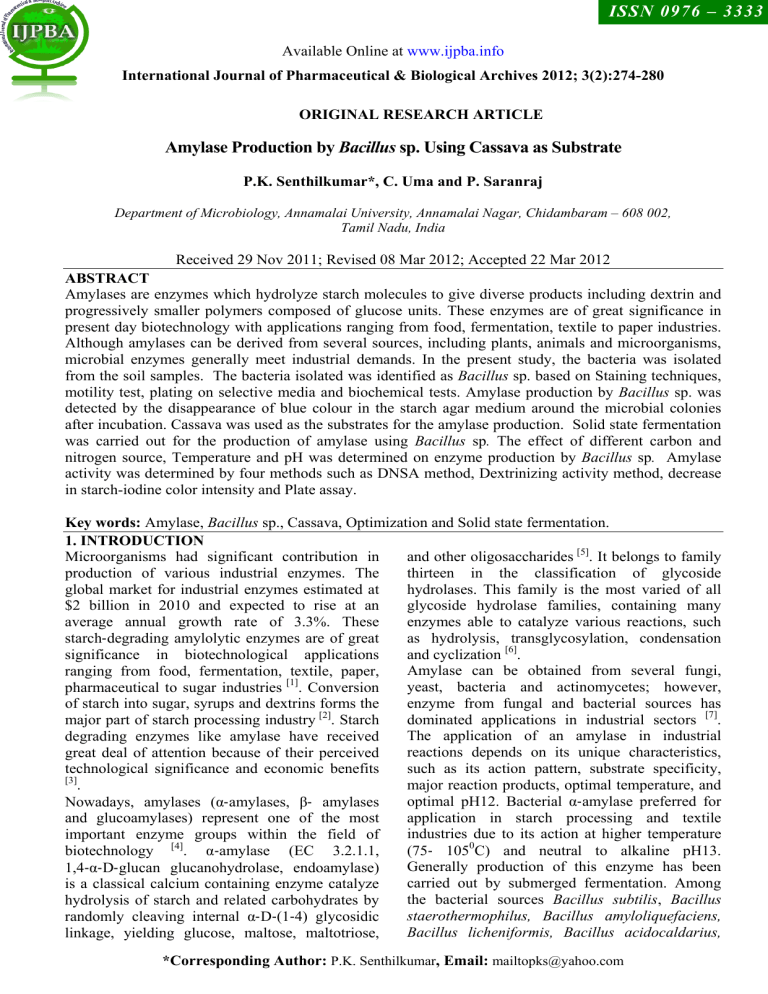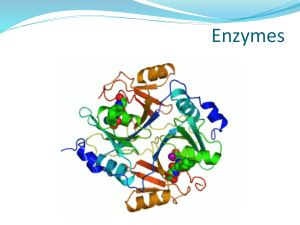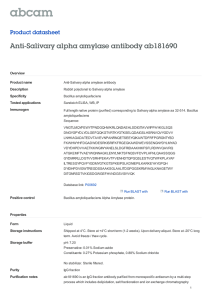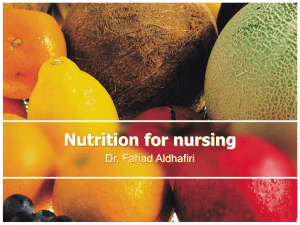
ISSN 0976 – 3333
Available Online at www.ijpba.info
International Journal of Pharmaceutical & Biological Archives 2012; 3(2):274-280
ORIGINAL RESEARCH ARTICLE
Amylase Production by Bacillus sp. Using Cassava as Substrate
P.K. Senthilkumar*, C. Uma and P. Saranraj
Department of Microbiology, Annamalai University, Annamalai Nagar, Chidambaram – 608 002,
Tamil Nadu, India
Received 29 Nov 2011; Revised 08 Mar 2012; Accepted 22 Mar 2012
ABSTRACT
Amylases are enzymes which hydrolyze starch molecules to give diverse products including dextrin and
progressively smaller polymers composed of glucose units. These enzymes are of great significance in
present day biotechnology with applications ranging from food, fermentation, textile to paper industries.
Although amylases can be derived from several sources, including plants, animals and microorganisms,
microbial enzymes generally meet industrial demands. In the present study, the bacteria was isolated
from the soil samples. The bacteria isolated was identified as Bacillus sp. based on Staining techniques,
motility test, plating on selective media and biochemical tests. Amylase production by Bacillus sp. was
detected by the disappearance of blue colour in the starch agar medium around the microbial colonies
after incubation. Cassava was used as the substrates for the amylase production. Solid state fermentation
was carried out for the production of amylase using Bacillus sp. The effect of different carbon and
nitrogen source, Temperature and pH was determined on enzyme production by Bacillus sp. Amylase
activity was determined by four methods such as DNSA method, Dextrinizing activity method, decrease
in starch-iodine color intensity and Plate assay.
Key words: Amylase, Bacillus sp., Cassava, Optimization and Solid state fermentation.
1. INTRODUCTION
Microorganisms had significant contribution in
and other oligosaccharides [5]. It belongs to family
thirteen in the classification of glycoside
production of various industrial enzymes. The
global market for industrial enzymes estimated at
hydrolases. This family is the most varied of all
glycoside hydrolase families, containing many
$2 billion in 2010 and expected to rise at an
average annual growth rate of 3.3%. These
enzymes able to catalyze various reactions, such
as hydrolysis, transglycosylation, condensation
starch‐degrading amylolytic enzymes are of great
and cyclization [6].
significance in biotechnological applications
Amylase can be obtained from several fungi,
ranging from food, fermentation, textile, paper,
yeast, bacteria and actinomycetes; however,
pharmaceutical to sugar industries [1]. Conversion
enzyme from fungal and bacterial sources has
of starch into sugar, syrups and dextrins forms the
[2]
dominated applications in industrial sectors [7].
major part of starch processing industry . Starch
The application of an amylase in industrial
degrading enzymes like amylase have received
reactions depends on its unique characteristics,
great deal of attention because of their perceived
such as its action pattern, substrate specificity,
technological significance and economic benefits
[3]
major reaction products, optimal temperature, and
.
optimal pH12. Bacterial α‐amylase preferred for
Nowadays, amylases (α‐amylases, β‐ amylases
application in starch processing and textile
and glucoamylases) represent one of the most
industries due to its action at higher temperature
important enzyme groups within the field of
[4]
(75‐ 1050C) and neutral to alkaline pH13.
biotechnology
. α‐amylase (EC 3.2.1.1,
Generally production of this enzyme has been
1,4‐α‐D‐glucan glucanohydrolase, endoamylase)
carried out by submerged fermentation. Among
is a classical calcium containing enzyme catalyze
the bacterial sources Bacillus subtilis, Bacillus
hydrolysis of starch and related carbohydrates by
staerothermophilus,
Bacillus amyloliquefaciens,
randomly cleaving internal α‐D‐(1‐4) glycosidic
Bacillus licheniformis, Bacillus acidocaldarius,
linkage, yielding glucose, maltose, maltotriose,
*Corresponding Author: P.K. Senthilkumar, Email: mailtopks@yahoo.com
IJPBA, Mar - Apr, 2012, Vol. 3, Issue, 2
P.K. Senthilkumar et al. / Amylase Production by Bacillus sp. Using Cassava as Substrate Green
Bifidobacterium bifidum and Bifidobacterium
acerans are important species [8].
The α-amylases from Bacillus licheniformis,
Bacillus
amyloliquefaciens
and
Bacillus
stearothermophilus are among the most widely
studied amylases and are highly homologous with
respect to primary and tertiary structure [9].
However, despite their structural similarities,
these reported amylases vary significantly in their
thermal stability. The thermal inactivation of
Bacillus α-amylases has been suggested to involve
a two-step process, with the first step of reversible
unfolding,
followed
by
an
irreversible
conformational change [10]. Calcium ions have also
been implicated in mechanisms involving the
thermal inactivation of the Bacillus α-amylases,
whereby it has been proposed that the first step
involves the reversible dissociation of calciumions
from the native enzyme, followed by irreversible
denaturation at high temperatures [11].
Amylase has a great deal of application in starch
saccharification. The amylolytic enzymes find a
wide spectrum of applications in food industry for
production of glucose syrups, high fructose corn
syrups, maltose syrups, reduction of viscosity of
sugar syrups, reduction of haze formation in
juices, solubilization and saccharification of starch
for alcohol fermentation in brewing industries,
and also find a wide range of application in
baking, paper, textile and detergent industry [12]. In
most cases the enzymatic process is inhibited by
high substrate and product concentration and also
instability of the enzyme under repetitive or
prolonged use. The present study was carried out
to evaluate the amylase activity of the amylolytic
bacteria using cassava waste as a feed substrate.
Pectinase production by different organisms in
submerged state fermentation has received more
attention and is found to be cost-prohibitive
because of high cost of process engineering.
2. MATERIALS AND METHODS
2.1. Substrates used
Cassava was obtained from Salem. The substrates
were ground into coarse powder with a blender.
2.2. Isolation and identification of Bacillus sp.
Pour plate technique was used for the isolation of
Bacillus sp. from soil sample. Well grown
bacterial colonies were picked and further purified
by streaking. The isolated strains were maintained
on Nutrient agar slants and stored in refrigerator at
4°C. Identification of the bacterial isolates was
carried out by the routine bacteriological methods
i.e., By the colony morphology, preliminary tests
like Gram staining, capsule staining, endospore
staining, motility, catalase and oxidase, plating on
selective medias and performing biochemical
tests.
2.3. Solid state fermentation
Five gram of substrate (Cassava) was taken into a
250 ml (flask) Erlenmeyer flask and to this a
bacterial amylase production containing (g/l)
KH 2 PO 4 – 1.4; NH 4 NO 3 – 10; KCl – 0.5;
MgSO 4 .7H 2 O – 0.1; FeSO 4 .7H 2 O – 0.01; starch –
20 gm; and distilled water was added to adjust the
require moisture level. The contents of the flaks
were mixed thoroughly and autoclaved at 121°C
for 20 min. Solid state fermentation was carried at
30°C with substrate initial moisture content of
64% for 72 hours using 2 ml Bacillus sp.
Suspension as inoculum. Studies were also
performed to evaluate the influence of
supplementation of substrate with different carbon
sources such as glucose, maltose, sucrose, lactose
(3% w/v) and nitrogen source such as peptone,
casein, urea, yeast extract (3% w/v).
2.4. Optimization of culture condition
The effect of culture conditions the present study
was carried out at different temperature (30, 40,
50 and 60°C), different pH (4, 5, 6 and 7),
different carbon sources such as (glucose,
maltose, lactose and sucrose) and nitrogen sources
such as (peptone, casein, urea, yeast extract) were
used to determine their effect on amylase
production.
2.5. Enzyme extraction
22 ml of 0.1 M phosphate buffer (pH-6.5) was
added to cultures, the mixture were shacked for 30
min at 19°C and 140 rpm on a rotary shaker. The
mixture was filtered through cheese cloth and
centrifuged at 8000 rpm at 4°C for 15 min. The
supernatant was filtered through Whattman
Number-1 filter paper and the filtrate was used as
the crude enzyme preparation.
2.6. Assay of enzyme activity
2.6.1. DNSA method
Assay system for amylase activity was carried out
by measuring the amount of reducing sugar
according to the DNSA method. Amylase activity
was determined by incubating a mixture of 1 ml of
aliquot of each enzyme source and 1% soluble
starch dissolved in 0.1 M phosphate buffer, at pH
7, at 55°C for 15 min. The reaction was stopped
by adding 1 ml of 3, 5 Dinitrosalicylic acid, and
then followed by boiling for 10 min. The final
volume was made up to 12 ml with distilled water
and the reducing sugar released was measured at
540 nm. One unit of amylase activity was defined
as the amount of enzyme that releasing 1µmol
glucose equivalent per minute under the assay
275
© 2010, IJPBA. All Rights Reserved.
P.K. Senthilkumar et al. / Amylase Production by Bacillus sp. Using Cassava as Substrate Green
conditions. Reducing sugar (Glucose or maltose)
concentration was determined from a standard
curve under same condition using glucose.
Calculation:
IJPBA, Mar - Apr, 2012, Vol. 3, Issue, 2
Microgram of glucose produced
Amylase activity (U/ml) =
Volume of enzyme solution x Incubation time
2.6.2. Dextrinizing activity method
Amylase was assayed by the iodine method with
slight modifications. Activity was estimated in a
reaction mixture containing 1.0 ml of 0.15%
soluble starch in 0.1M acetate buffer, pH 5.5,
200mM CaCl 2 and 1.0 ml enzyme and incubated
at 65°C for 10 min. After incubation, 1.0 ml of 1
M acetic acid, 1.0 ml of 0.2% iodine, 2.0% KI
solution and 15 ml of distilled water were added.
The absorbance of the diluted solution was
measured at 620 nm. A blank was prepared under
the same condition by adding enzyme solution
after the reaction had been stopped by the addition
of 1.0M acetic acid. One unit of dextrinizing
activity was defined as the amount of enzyme
which hydrolyzes 1ml of starch/10minutes under
the above conditions. Starch concentration was
determined from a standard curve under the same
assay condition using soluble starch.
Calculation:
Microgram of glucose produced
Amylase activity (U/ml) =
Volume of enzyme solution x Incubation time
2.6.3. Decrease in starch-iodine color intensity
Starch forms a deep blue complex with iodine and
with progressive hydrolysis of the starch, it
changes to red dish brown. Several procedures
have been described by various groups for the
quantitative determination of amylase based on
this property.
This method determines the
dextrinizing activity of amylase in terms of
decrease in the iodine color reaction.
2.6.4. Plate assay
The plate assay was performed using agar plates
amended with starch. The agar plates were
prepared amended 2% of starch with 1.5% of
agar. After agar solidification, around 10 mm
diameter of well was cut out aseptically with the
help of cork borer. The well was filled with the
culture filtrate and incubated at 37°C for
overnight. 1% of iodine solution was over layered
on the agar and the observation was made to see
the hydrolytic zone around the well. The negative
control was maintained by adding sterile water in
the separate well.
2.7. Estimation of protein concentration
The protein concentration was estimated by the
following the method of Lowry et al. [13] using
Bovine serum albumin as the standard.
3. RESULTS AND DISCUSSION
Enzymes are substances present in the cells of
living organisms in minute amounts and are
capable of speeding up chemical reactions
(associated with life processes), without
themselves being altered after the reaction. They
accelerate the velocity of the reaction without
necessarily initiating it. There are three major
sources of enzymes [14], that is derived from a
variety of plants, e.g. pappain, animal enzymes –
derived from animal glands, e.g. trypsin, pepsin
and microbial enzymes – derived from micro
organisms (fungal and bacterial) through the
process of fermentation, e.g. amylase. Microbial
enzymes are preferred to those from both plants
and animal sources because they are cheaper to
produce, and their enzyme contents are more
predictable, controllable and reliable [14].
Amylases are examples of hydrolases and
function in the hydrolysis of molecules. Amylases
are of the most important enzymes used in
biotechnology [14]. Their use includes hydrolysis
of starch to yield glucose syrup, amylase-rich
flour and in the formation of dextrin during
baking in food industries. Furthermore, in the
textile industry, amylases are used for removal of
starch sizing and as additives in detergents [15].
Cheap and readily available agricultural waste
such as cassava peels, which presently constitutes
a menace to solid waste management, may be a
rich source of amylolytic bacteria [16]. Therefore,
the main objectives of the study were to isolate
and identify amylolytic bacteria from cassava
waste dumpsites, and to perform partial
characterization of the enzyme production and its
properties with regard to the effect of temperature.
In this present study, the bacterial isolate showing
superior amylase production gave the following
preliminary characterization: gram-positive spore
forming bacilli, approximately one micron in
length, with central spores usually smaller than
the cell. Agar colonies were small, smooth,
glistening, and round, or intermediate in size, flat,
rough, and irregular, or sometimes rather large,
spreading, and mucoid. The great majority of
isolates fermented glucose and sucrose with the
production of acid. Lactose was not fermented.
Most of them liquefied gelatin completely within
72 hours. Provisionally, they all appear to fit into
the Bacillus sp. group. The Bacillus sp. was
isolated and characterized by Gram staining,
motility test, selective medium and bio-chemical
tests. Amylase activity was preliminarily checked
by plating the Bacillus cereus on the Starch agar
medium, the medium was flooded using iodine
276
© 2010, IJPBA. All Rights Reserved.
IJPBA, Mar - Apr, 2012, Vol. 3, Issue, 2
P.K. Senthilkumar et al. / Amylase Production by Bacillus sp. Using Cassava as Substrate Green
indicator, clear zone around the colony indicated
the presence of amylase activity.
Members of the genus Bacillus are heterogeneous
and they are very versatile in their adaptability to
the environment. There are various factors that
influence the nature of their metabolic processes
and enzymes produced [17]. A great deal of
attention is being given to thermophilic and
extremely thermophilic microorganisms and their
enzymes [17]. Bacillus species produce a large
variety of extra cellular enzymes, such as
amylases, which have significant industrial
importance [18]. In the same vein, bacterial
enzymes are known to posses more
thermostability than fungal amylases [19].
In this present study, the effect of temperature on
amylase production by Bacillus sp. using cassava
waste as substrate was carried out at various
temperature viz., 30, 40, 50 and 60°C. The
enzyme production was maximum at 60°C (3.9
U/ml) and minimum at 30°C (2.9 U/ml) (Fig 1).
The effect of pH on amylase production by
Bacillus sp. was carried out at various pH viz.,4, 5,
6 and 7 . The enzyme production was maximum at
pH 7 (3.8 U/ml) and minimum at pH 4 (2.8 U/ml)
(Fig 2).
In this present research, the effect of various
carbon sources like Glucose, Maltose, Sucrose
and Lactose was tested on amylase production by
Bacillus sp. using cassava waste as substrate. The
amylase production was high in the medium
containing Glucose (4.2 U/ml) (Fig 3). The effect
of nitrogen sources like Peptone, Yeast extract;
Casein and Urea were tested for the amylase
production. Among the various nitrogen sources
tested, peptone (3.5 U/ml) maximum amylase
production (Figure-4). Amylase activity was
determined by Dinitrosalicylic acid assay (4.6
U/ml), Dextrinizing activity (9.2 U/ml), Decrease
in starch-iodine color intensity, Plate assay (15
mm) (Table 1).
The influence of temperature on amylase
production is related to the growth of the
organism. Among the fungi, most amylase
production studies have been done with
mesophilic fungi within the temperature range of
25 to 35°C. Optimum yields of α-amylase were
achieved at 30 to 37°C for Aspergillus oryzae [20].
α-Amylase production has also been reported at
55°C
by
the
Thermophilic
fungus
Thermomonospora fusca and at 50°C by
Thermomonospora lanuginosus [21]. α-Amylase
has been produced at a much wider range of
temperature among the bacteria. Continuous
production
of
amylase
from
Bacillus
amyloliquefaciens at 36°C has been reported.
However, temperatures as high as 80°C have been
used for amylase production from the
hyperthermophile Thermococcus profundus.
Among the physical parameters, the pH of the
growth medium plays an important role by
inducing morphological change in the organism
and in enzyme secretion. The pH change observed
during the growth of the organism also affects
product stability in the medium. Most of the
Bacillus strains used commercially for the
production of bacterial α-amylases by SmF have
an optimum pH between 6.0 and 7.0 for growth
and enzyme production. This is also true of strains
used in the production of the enzyme by SSF. In
most cases the pH used is not specified excepting
pH 4.2 in the case of Aspergillus oryzae, 8.0 in
Aspergillus oryzae and 6.8 for Bacillus
amyloliquefaciens [22].
The carbon sources as glucose and maltose have
been utilized for the production of α-amylase.
However, the use of starch remains promising and
ubiquitous. A number of other non-conventional
substrates as lactose, casitone, fructose, oilseed
cakes [23] and starch processing waste water. Cui
YQ et al. [24] have also been used for the
production of α-amylase while the agroprocessing by-product, wheat bran has been used
for the economic production of α-amylase by SSF.
The use of wheat bran in liquid surface
fermentation (LSF) for the production of αamylase from Aspergillus fumigates and from
Clavatia gigantea, respectively, has also been
reported. High α-amylase activities from
Aspergillus fumigatus have also been reported
using α-methyl-Dglycoside (a synthetic analogue
of maltose) as substrate.
Organic nitrogen sources have been preferred for
the production of α-amylase. Yeast extract has
been used in the production of α-amylase from
Streptomyces sp., Bacillus sp. and Halomonas
meridian [25]. Yeast extract has also been used in
conjunction with other nitrogen sources such as
bactopeptone in the case of Bacillus sp.,
ammonium sulphate in the case of Bacillus
subtilis, ammonium sulphate and casein for C.
gigantea and soybean flour and meat extract for
Aspergillus oryzae. Yeast extract increased the
productivity of α-amylase by 156% in Aspergillus
oryzae when used as an additional nitrogen source
than when ammonia was used as a sole source.
Various other organic nitrogen sources have also
been reported to support maximum α-amylase
production by various bacteria and fungi.
However, organic nitrogen sources viz. beef
277
© 2010, IJPBA. All Rights Reserved.
P.K. Senthilkumar et al. / Amylase Production by Bacillus sp. Using Cassava as Substrate Green
extract peptone and com steep liquor supported
maximum α-amylase production by bacterial
strains soybean meal and amino acids by
Aspergillus oryzae [26]. CSL has also been used for
the economical and efficient production of αamylase from a mutant of Bacillus subtilis. Apart
from this, various inorganic salts such as
ammonium sulphate for Aspergillus oryzae and
Aspergillus nidulans, ammonium nitrate for
Aspergillus oryzae and Vogel salts for Aspergillus
fumigatus have been reported to support better αamylase production in fungi [27].
Fig 4: Effect of nitrogen sources on amylase production
by Bacillus sp.
Fig 1: Effect of temperature on amylase production by
Bacillus sp.
Table 1: Assay of amylase enzyme activity
S. No
IJPBA, Mar - Apr, 2012, Vol. 3, Issue, 2
1
2
3
Fig 2: Effect of pH on amylase production by Bacillus sp.
Method
Dinitro sacicyclic acid method (U/ml)
Dextrinizing activity (U/ml)
Plate assay (Diameter of zone in mm)
Results
4.6
9.2
15
CONCLUSION
Research on amylase has progressed very rapidly
over the last five decades and potential industrial
applications of the enzyme especially in solid
waste management have been identified. Major
impediments to exploit the commercial potential
of amylase are the yield, stability and cost of
amylase production. Although microbes have
been extensively studied by many researchers.
The bacteria Bacillus sp. was used for the
production of amylase and cassava wastes were
used as a substrate.
REFERENCES
Fig 3: Effect of carbon sources on amylase production by
Bacillus sp.
1. Kunamneni A, Permaul K and Singh S.
2005. Amylase production in solid state
fermentation by the thermophillic fungus
Thermomyces funginosus. Journal of
Bioscience and Bioengineering, 100 (2):
168‐171.
2. Aiyer PV. 2005. Amylase and their
applications.
African
Journal
of
Biotechnology, 4 (13): 1525‐1529.
3. Gupta A, Gupta VK, Modi DR and
Yadava LP. 2008. Production and
characterization of α‐amyase from
Aspergillus niger. Biotechnology, 7(3):
551‐556.
4. Rodriguez VB, Alam Eda EJ, Gallegor JF
and Requena AR. 2006. Modification of
the activity of an α‐amylase from Bacillus
licheniformis by several surfactants.
Electronic Journal of Biotechnology, 9(5):
DOI:10.225/vol9‐issue5‐fulltext‐16.
278
© 2010, IJPBA. All Rights Reserved.
IJPBA, Mar - Apr, 2012, Vol. 3, Issue, 2
P.K. Senthilkumar et al. / Amylase Production by Bacillus sp. Using Cassava as Substrate Green
5. Ryan SM, Fitzgerald GF and Sinderen D.
Screening for identification of starch‐,
amylopectin‐, and pullulan‐degrading
activities in bifidobacterial strains. Applied
Environmental Microbiology, 72 (8) :
5289‐5296.
6. Ali MB, Khemakhem B, Robert X, Haser
R and Bejar S. 2006. Thermostability
enhancement and change in starch
hydrolysis profile of the maltohexaose
forming
amylase
of
Bacillus
stearothermophilus strain. Biochem J.,
394:51‐56.
7. Kathiresan K and Manivannan S. 2006.
α‐Amylase production by Penicillum
fellutanum isolated from mangrove
rhizosphere soil. African Journal of
Biotechnology, 5 (10): 829‐832.
8. Rohban, R., M.A. Amoozegar and A.
Ventosa, 2008. Screening and isolation of
halophilic bacteria producing extracellular
hydrolyses from Howz Soltan Lake, Iran.
J. Ind. Microbiol. Biotechnol., 36: 333340.
9. Nielsen, A.D., M.L. Pusey, C.C. Fulsgang
and P. Westh. 2003. A proposed
mechanism for the thermal denaturation of
a recombinant Bacillus halmapalus
amylase - the effect of calcium ions.
Biochim. Biophys. Acta., 1652: 52– 63.
10. Fitter,J., R. Herrmann, N.A. Dencher, A.
Blume, and T. Hauss. 2001. Activity and
stability of a thermostable amylase
compared to its Mesophilic homologue:
mechanisms of thermal adaptation,
Biochemistry, 40: 10723–10731.
11. Simons,J.W.F.A., H.A. Kosters, R.W.
Visschers and H.H.J. de Jongh. 2002. Role
of calcium as trigger in thermal hlactoglobulin aggregation. Arch. Biochem.
Biophys., 406 : 143– 152.
12. Sivaramakrishnan, S., Gangadharan, D.,
Nampoothiri, K. M., and Pandey, A.
(2006). Amylases from microbial sources
– An overview on recent developments.
Food Technology and Biotechnology,
44(2): 173–184.
13. Lowry, O.H., N.J. Rosebrough, A.L. Farr
and
R.J.Randall.
1951.
Protein
measurement with the folin phenol
reagent. J. Biol. Chem., 193: 267–275.
14. Burhan A, Nisa U, Gokhan C, Ashabil A
and Osmair G. 2003. Enzymatic Properties
of a novel thermostable thermophilic
alkaline and chelator resistant amylase
from an alkaphilic Bacillus sp Isolate.
Process Biochemistry. 38: 1397–1403.
15. FAO. 2001. Review: Enzyme Applications
for Agro-Processing in Development
Countries. An Inventory of Current and
Potential Application http://www.FAO.
Org,ag/ags/ags.
16. Ali S, Mahmood S, Alan R and Hossain Z.
1998. Culture Conditions for Production of
glucoamylase from rice bran by
Aspergillus terreus. MIRCEN J. Appl.
Microbiol. Biotechnol., 5: 525 – 532.
17. Ajayi AO and Fagade OE. 2006. Growth
pattern and structural nature of amylases
produced by some Bacillus species in
starchy substrates. Afr. J. Biotechnol.,
5(5): 440-444.
18. Cordeiro CAM, Martinas MLL and
Lucaino A. 2003. Production and
Properties of alpha amylase from
thermophylic Bacillus species. Braz. J.
Microbiol., 33:1-3.
19. Eke OS and Oguntimehin GB. 1992.
Partial purification and characterization of
alpha amylase from Bacillus cereus BC.
19p. J. Agric. Sci. technol., 2(2):152-157.
20. Khoo SL, Amirul A-A, Kamaruzaman M,
Nazalan N and Azizan MN. 2004.
Purification and characterization of
amylase from Aspergillus flavus. Folia
Microbiol., 39: 392-398.
21. Giri NY, Mohan AR, Rao LV and Rao CP.
2000. Immobilization of amylase complex
in detection of higher oligosaccharides on
paper. Curr Sci., 59:1339-1340.
22. Agger T, Spohr AB, Carlsen M and
Nielsen J. 1998. Growth and product
formation of Aspergillus oryzae during
submerged cultivations: verification of a
morphologically structured model using
fluorescent probes. Biotechnol Bioeng.,
57:321-329.
23. Dhanya
Gangadharan,
Madhavan
Nambothari, Sweetha Ramakrishnan and
Ashok Pandey. 2009. Immobilized
bacterial amylase for effective hydrolysis
of raw and soluble starch. Food Research
International, 42: 436-442.
24. Cui YQ, Van der Lans RGJM and Luyben
KCAM. 2007. Effect of agitation
intensities on fungal morphology of
submerged
fermentation.
Biotechnol
Bioeng., 55:715-726.
279
© 2010, IJPBA. All Rights Reserved.
P.K. Senthilkumar et al. / Amylase Production by Bacillus sp. Using Cassava as Substrate Green
27. Wu WX, Mabinadji J, Betrand TF and Wu
WX. 2009. Effect of culture conditions on
the production of an extracellular
thermostable alpha-amylase from an
isolate of Bacillus sp. J Zhejiang Univ
Agric Life Sci., 25:404-408.
IJPBA, Mar - Apr, 2012, Vol. 3, Issue, 2
25. Spohr A, Carlsen M, Nielsen J and
Villadsen
J.
1997.
Morphological
characterization of recombinant strains of
Aspergillus oryzae producing a-amylase
during batch cultivations. Biotechnol Lett.,
19:257-261.
26. Hillier P, Wase DAJ, Emery AN and
Solomons GL. Instability of aamylase
production and morphological variation in
continuous
culture
of
Bacillus
amyloliquefaciens is associated with
plasmid loss. Process Biochem., 32:51-59.
280
© 2010, IJPBA. All Rights Reserved.






